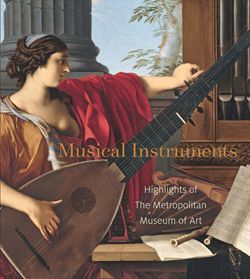Plate with trumpeter
This polychrome plate features a depiction of a man playing a trumpet in its inner roundel. The sloping perimeter of the plate was embellished with continuous bands of design units that encircle the main figure. The designs are all executed in red, black, and white on a vibrant orange ground. The surface of the entire plate has been burnished to a high glossy sheen. The triangular and T-shaped areas with crosshatching imitate woven fibers such as textiles or basketry. An L-shaped string of six glyphs, outlined in red, appears to the left of the figure's head, above the trumpet. Known as pseudo-glyphs, these illegible hieroglyph-shaped images are meant to evoke writing.
The central figure is represented in profile wears an elaborate ensemble of finery. This is comprised of a white textile tunic with a fringe of dangling feathers, a feathered headdress, an earspool assemblage and a large feathered bracelet, and a belt that features a large, goggle-eyed mask at the back of his waist. The painter incorporated the mask facing outward, the frontal view adding emphasis to this costume element and making it the single most compelling element of the composition. The goggle eyes, U-shaped element of the upper lip, and “trapeze-and-ray” headdress of this belt ornament are all motifs that refer to the Central Mexican metropolis of Teotihuacan (ca. 100–700 CE). Maya rulers incorporated such imagery into their regalia, long after the city had been burned and abandoned around 700 CE, as a nod to their ancestral connections with that faraway place. The figure also wears sandals and bands of body paint on his legs and face.
Long wooden (or ceramic) trumpets of the type the figure holds to his mouth are featured in the well-known murals at the site of Bonampak, Chiapas, Mexico (ca. 770–790 CE). Music was an important aspect of Maya ceremony, with drums, trumpets, and singers depicted in a variety of different mortal and supernatural scenes in an array of media. Such trumpets continued to be played in the Maya area until well after the Spanish conquest of the sixteenth century. At that time, they still were reported as an accompaniment to certain ceremonial dances.
Maya hieroglyphic texts attest to several varieties of plates used for different foods during the Classic period (ca. 250–900 CE). This type of shallow plate is often associated with tamales of corn or sometimes deer meat. The exceptional preservation of this particular plate may indicate that it was not used in ritual feasting, but was prepared primarily as a funerary offering.
James Doyle, 2017
This image cannot be enlarged, viewed at full screen, or downloaded.



